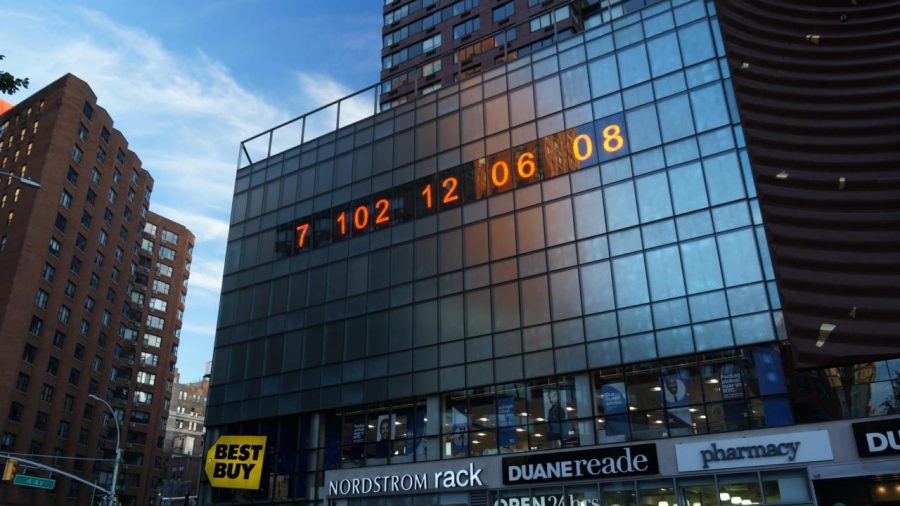Talk About the Climate Clock
December 5, 2020
Metronome, which features a larger-than-life 15-digit, 24-hour clock, has been one of New York’s most prominent art projects for more than 20 years. Recently, this Manhattan clock was reprogrammed to display Gan Golan’s and Andrew Boyd’s Climate Clock, presenting a window of time left to take action before the effects of climate change threaten to alter our world. Displayed in one of America’s largest cities at 62-feet wide, facing Union Square, it’s hard for pedestrians to miss.
Many of us know that climate change, which is the long term warming of Earth’s atmosphere due to the buildup of greenhouse gases, has become a major problem. However, the situation has dramatically worsened throughout the last few decades. Levels of a primary greenhouse gas, carbon dioxide, have risen to dangerous levels due to the burning of fossil fuels from planes, cars, and factories. This is depleting Earth’s carbon budget: the maximum amount of carbon dioxide that can be emitted into the atmosphere and still keep the increase in the global average temperature to well below 2°C above pre-industrial levels. The 2°C figure was agreed upon by all signatories of the 2016 Paris Agreement.
The digital Climate Clock displays the amount of time left to act before climate damage on our planet is irreversible. As of right now, there are just over seven years before Earth’s carbon budget is depleted, according to current carbon emission rates. The clock provides two numbers: the first is a deadline, which counts down how long it will take for the world to burn through this carbon. The second is considered to be a “lifeline,” which gives the percentage of available energy from renewable resources. “Simply put, we need to get our lifeline to 100% before our deadline reaches 0,” the clock’s website states.
This official website also offers an interactive graph that tracks the global temperature and the level of emissions over a period of time based on the speed of action and the size of the investment. The y-axis of the graph shows the level of risk to Earth as the global temperature and emission rates increase. One of the worst-case scenarios, with little action and low investments, shows that the global temperature could reach over 38℉ by 2100. For reference, in 2020, the temperature is just over 34.5℉. Even though a 3.5℉ increase might not feel that different in our daily lives, this level of increase is exponentially higher than past escalations of global temperatures.
According to NASA, even a half-degree increase has the power to majorly impact life on Earth, with significant changes in ecosystems, as well as the intensity of droughts, flooding, tropical storm damages, and ice melting. With a 3.5℉ increase, civilization as we know it would no longer be possible. Permanently inhabitable regions, mass extinctions, billions of climate refugees, and the death of hundreds of millions of people are some of the complications of this temperature increase, according to the Climate Clock website.
With the maximum speed of action and maximum amount of investment, the graph shows that it is possible to get the global temperature even lower than it is right now by 2100, to about 34.4℉. The graph depicts the level of seriousness of this global issue, providing the statistics that portray the unbelievable ways our world could be permanently altered, even in the next 10 years.
With rising ocean temperatures and the monstrous impacts on ocean life, it has become obvious that our world needs significant change. The Climate Clock helps us to visualize exactly what the effects of our actions on our planet will look like in the coming years.
The Climate Clock doesn’t just exist in Manhattan. There are clocks all over the world, and the website even provides instructions on how to make your own at home. However, the recent unveiling of the clock in New York has received much-needed attention from news stations, environmentalists, and people looking to educate, learn, and make a difference. As the website states over and over, “If we shift our priorities now, we can change the future.”
This larger-than-life visualization of the time running out for humans to change their behavior gives a sense of reality, with the future of our planet at stake. The presence of the Climate Clock shows the need, now more than ever, to take some serious action to improve the health of Earth for future generations. After all, there are only seven short years before our world will be irreversibly damaged by the impacts of climate change and carbon emissions. And that’s permanent.


